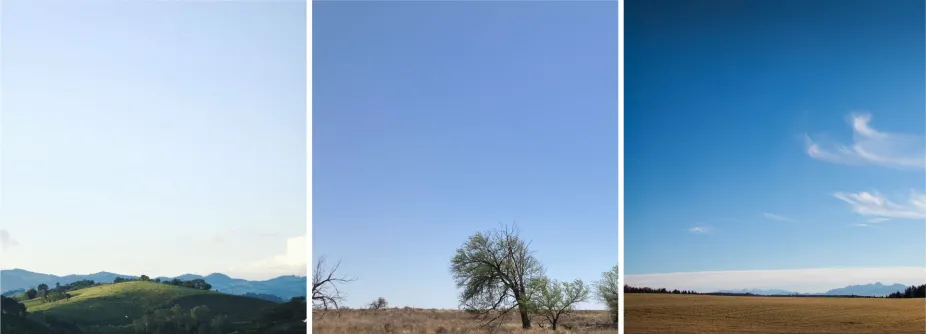The Colors of the Sky
Sunlight, or visible light, is made of all the rainbow colors: red, orange, yellow, green, blue, indigo, and violet. The light travels in waves that are too small and fast for us to see. Colors like red, orange, and yellow travel in longer waves and have less energy. Colors like blue, indigo, and violet travel in shorter waves and have more energy. When light is moving through the atmosphere, some of the waves are scattered, which gives the sky its color.
Why Is the Sky Blue?
Light from the Sun is scattered in all directions by molecules of air as well as particles like aerosols and dust. Shorter waves of light, like violet and blue, are the most likely to be scattered by air molecules. The sky looks blue because we see the scattered blue light. (If our eyes were better able to see violet light, then the sky would look violet in color.)
But the sky isn't the same color blue every day. Sometimes you'll notice that it's a lighter blue, and other times it's a darker blue. That's because of aerosols in the atmosphere. Aerosols are tiny particles and liquid droplets in the air. Some aerosols form naturally from sea salt and volcanic eruptions. Others are formed when people burn fossil fuels or wood. When there are few aerosols in the air, the sky appears clear and deep blue during the day. When there are more aerosols in the air, the sky is a more pale blue color. When there are lots of aerosols, the sky might even look white in the middle of the day, even if there are no clouds.

The sky isn't always the same color blue. When there are little particles in the air called aerosols, the sky is a lighter blue.
Piqsels (left and right), L.S. Gardiner (center)
Sunset Sky Colors
During sunrise and sunset, the Sun is low in the sky. Light has to travel through more atmosphere than it does when it’s overhead. This causes the light to scatter, and we see shades of red, orange, or yellow, which are the longer wavelengths of light. That’s why the setting Sun often looks red!
When there are lots of aerosols in the atmosphere, even more sunlight is scattered and absorbed. This scattering of sunlight can make the sky look hazy. It also makes sunsets more colorful and red.
Make a Model of the Sky’s Colors
What you'll need:
- Tall clear drinking glass or clear soda bottle
- Water
- A few drops of milk (whole milk works best)
- A drinking straw
- A flashlight
Try it!
- Darken the room by closing the shades and turning off the lights.
- Shine the light through the glass of water. What color is the light coming from the flashlight? What color is the light as it travels through the glass? (You might want to put a sheet of white paper on the far side of the glass to help you see the color.)
- Fill the straw with about an inch of milk, add it to the glass of water, and mix with the straw. (If you are using a soda bottle, you will need to use more milk, cap the bottle, and shake gently.)
- Shine a flashlight at the top of the glass of water. What color is the light coming from the flashlight? What color is the light as it travels through the glass? What color is the light on the far side of the glass?
- If you don't see any change in color, add a couple more drops of milk to the mixture and try again.